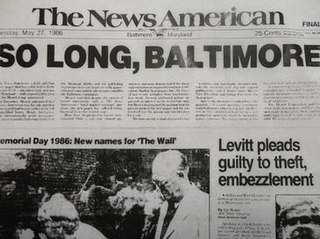
The Whig was a polemical American newspaper published and edited by William G. "Parson" Brownlow (1805–1877) in the mid-nineteenth century. As its name implies, the paper's primary purpose was the promotion and defense of Whig Party political figures and ideals. In the years leading up to the Civil War, the Whig became the mouthpiece for East Tennessee's anti-secessionist movement. The Whig was published under several names throughout its existence, namely the Tennessee Whig, the Elizabethton Whig. the Jonesborough Whig, the Knoxville Whig, and similar variations.

Francis Preston Blair Sr. was an American journalist, newspaper editor, and influential figure in national politics advising several U.S. presidents across party lines.

The Baltimore News-American was a broadsheet newspaper published in downtown Baltimore, Maryland until May 27, 1986. It had a continuous lineage of more than 200 years. For much of the mid-20th Century, it had the largest circulation in the city.
The Star Democrat is an American newspaper published and mainly distributed in Easton, Maryland, in Talbot County, as well as in the surrounding counties of Caroline, Dorchester, Queen Anne's and Kent. The Star Democrat is published daily except on Mondays and Saturdays.
The Capital is a daily newspaper published in Annapolis, Maryland, to serve the city of Annapolis, much of Anne Arundel County, and neighboring Kent Island in Queen Anne's County. First published as the Evening Capital on May 12, 1884, the newspaper switched to mornings on March 9, 2015.
Der Baltimore Wecker was a daily paper published in the German language in Baltimore, Maryland. It was the object of violence in the civil unrest at Baltimore in April 1861 that produced the first bloodshed of the American Civil War.
The Commercial Journal was a mid-19th century newspaper in Pittsburgh, Pennsylvania, United States.

The Advocate was a newspaper published in Pittsburgh, Pennsylvania, under several title variants from 1832 to 1844. It was the second daily newspaper issued in the city, the first being its eventual purchaser, the Gazette. Politically, the paper supported the principles of the Whig Party.

Der Deutsche Correspondent was a German-language newspaper in Baltimore, Maryland. It was the most influential newspaper among Germans in Baltimore, lasting longer than any of the other German newspapers in Maryland.

The New York Evening Express (1836–1881) was a 19th-century American newspaper published in New York City.

The Civilian & Telegraph was a Unionist newspaper published weekly in Cumberland, Maryland, from 1859 to 1905. It was created on March 17, 1859, from the merger of two newspapers, the Civilian and Telegraph. William Evans and John J. Maupin were the first editors.

The Daily Exchange was a daily newspaper published in Baltimore, Maryland, United States from 1858 to 1861. It was originally owned and edited by Charles G. Kerr and Thomas Hall Jr. In 1859, Henry Fitzhugh, William Carpenter, and Frank Key Howard bought into the paper. Howard soon headed the editorial staff and Severn Teackle Wallis contributed editorial columns frequently.

The Baltimore Commercial Journal and Lyford's Price-Current was a weekly business newspaper published in Baltimore, Maryland, between 1840 and 1849. Printed by William G. Lyford, the paper was a revival of the defunct Baltimore Price Current. It was succeeded by the Baltimore Price-Current and Weekly Journal of Commerce.

The Maryland Free Press was a weekly newspaper published in Hagerstown, Md., from 1862 to 1876, with a hiatus from 1863 to 1866. Its editorial perspective included support for secession, the Confederacy, and the Democratic party.
The Baltimore County Union was a weekly newspaper published in Towsontown, Baltimore, Maryland from January 7, 1865 to June 8, 1912. When John H. Longnecker combined his pro-Union paper, the Baltimore County American, with the Baltimore County Advocate to create The Baltimore County Union, he placed his sons Henry and John in charge of the new weekly. Its inaugural issue claimed that it had the "largest circulation of any county paper in the State." The publication's main competitor in Towsontown was the Maryland Journal, a Democratic paper run by William H. Ruby.









